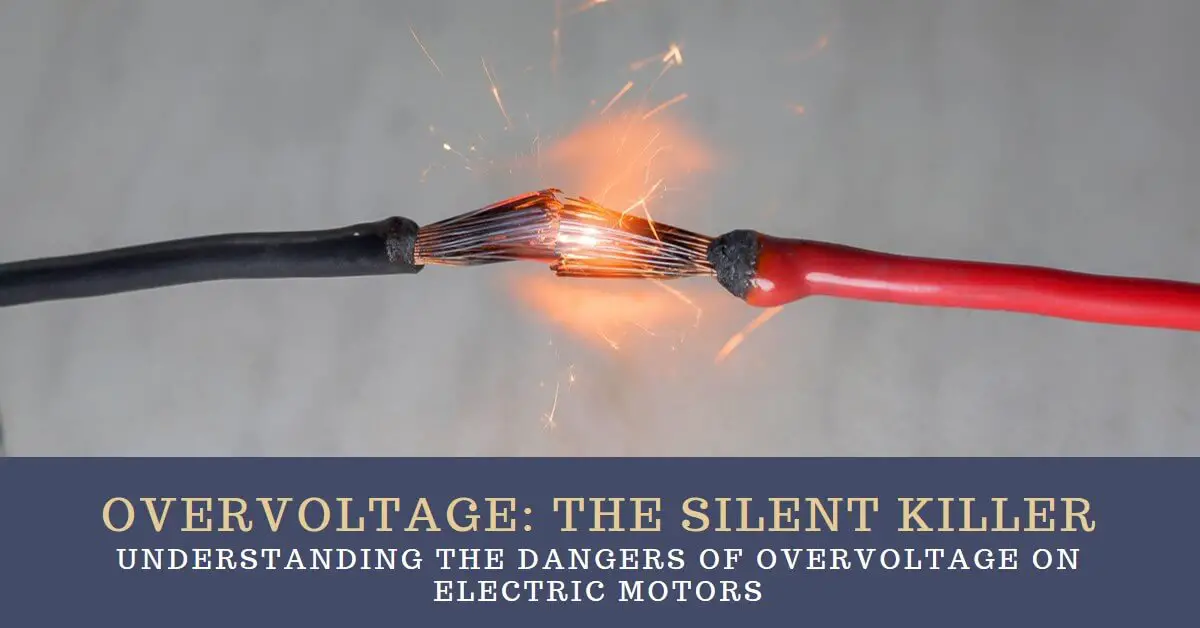Image: “Article Feature Image” by Bing is licensed under CC BY-NC-SA 4.0. Source: Bing Graphic Art. License: CC BY-NC-SA 4.0.
Electric motors are indispensable components in various industries and everyday appliances, powering everything from industrial machinery to household appliances.
However, they are susceptible to the damaging effects of overvoltage, which can lead to insulation breakdown, increased thermal stress, reduced efficiency, mechanical damage, and potential motor failure.
In this article, we will explore the causes and effects of overvoltage on electric motors, as well as delve into preventive measures and protection techniques to mitigate these risks.
I. Understanding Electric Motors and their Operation:
Electric motors are electromechanical devices that convert electrical energy into mechanical energy.
They consist of essential components such as the stator, rotor, and windings. The stator is the stationary part, while the rotor is the rotating part of the motor.
The windings, which are typically made of copper or aluminum, generate the electromagnetic fields necessary for motor operation.
The motor’s efficiency and performance depend on the proper functioning of these components.
II. Effects of Overvoltage on Electric Motors:
Overvoltage refers to a situation where the voltage supplied to a motor exceeds its rated voltage.
This can occur due to various factors, such as power surges, lightning strikes, or electrical faults.
The effects of overvoltage on electric motors can be significant and detrimental. Let’s explore them in detail:
A. Impact on Motor Windings:
The windings in electric motors are insulated to prevent electrical shorts and ensure efficient operation. However, overvoltage can lead to insulation degradation.
The excessive voltage stress weakens the insulation material, compromising its dielectric properties.
This can result in insulation breakdown, leading to motor malfunctions and potential failures. Moreover, overvoltage shortens the lifespan of motor windings, reducing the overall reliability and longevity of the motor.
B. Thermal Stress on Electric Motor Insulation:
Overvoltage causes an increase in the motor’s temperature rise. As voltage increases, so does the current flowing through the windings.
The increased current generates more heat, which raises the motor’s operating temperature. This elevated temperature can accelerate insulation aging, reduce insulation resistance, and ultimately lead to insulation failure.
It is crucial to monitor and control the operating temperature of the motor to prevent excessive thermal stress caused by overvoltage.
C. Increased Current and its Impact on Motor Components:
Overvoltage causes an increase in current flow through the motor windings. The higher current leads to increased power dissipation and can result in conductor overheating.
This overheating not only affects the efficiency and performance of the motor but also poses a significant risk of damage to the motor’s control devices, such as relays and contactors.
The sustained exposure to overvoltage-induced high currents can cause these components to fail prematurely.
D. Mechanical Stress and Overvoltage Effects on Bearings:
Electric motors rely on bearings to support and facilitate the smooth rotation of the rotor. Overvoltage can induce mechanical stress on bearings, leading to increased friction and accelerated wear.
The higher voltage can cause arcing or sparking within the motor, which can generate localized heat and cause pitting or damage to the bearing surfaces.
If not addressed promptly, overvoltage-induced bearing failure can result in motor malfunctions and downtime.
III. Effects of Overvoltage on Motor Efficiency and Performance:
Overvoltage not only affects the internal components of electric motors but also impacts their efficiency and overall performance. The following effects are commonly observed:
A. Decreased Motor Efficiency:
Overvoltage causes motors to operate outside their design parameters, leading to decreased efficiency. When a motor operates at a voltage higher than its rated value, it draws more current to compensate for the increased voltage.
This increased current results in higher energy losses and reduced overall efficiency. The motor consumes more electrical energy while delivering the same mechanical output, leading to inefficiencies and increased operating costs.
B. Abnormal Motor Operation:
Overvoltage can cause irregularities in motor behavior. The motor may experience fluctuations in speed, torque, or even unexpected shutdowns.
These abnormal operating conditions can disrupt industrial processes, affect product quality, and result in operational inefficiencies.
C. Vibration and Noise Issues:
Overvoltage can contribute to increased vibration and noise levels in electric motors. The imbalance caused by the irregularities in motor operation can lead to excessive vibrations, which not only affect the motor’s performance but can also impact the overall machinery or appliance in which the motor is integrated.
Excessive noise levels can also be a byproduct of overvoltage-induced mechanical stress and bearing wear.
IV. Safety Concerns and Overvoltage Protection Measures:
Overvoltage poses safety hazards to both personnel and equipment. It is crucial to implement adequate protection measures to safeguard against overvoltage risks.
The following measures can help mitigate the impact of overvoltage on electric motors:
A. Electrical Hazards and Personnel Safety:
Overvoltage can result in electrical faults and create hazardous conditions for operators and maintenance personnel.
Electrical shock, arc flashes, or even electrical fires are potential risks associated with overvoltage incidents.
Adhering to safety regulations, ensuring proper training for personnel, and implementing safety protocols can minimize these risks.
B. Overvoltage Protection Devices:
Surge protectors, voltage regulators, and other protective devices play a vital role in preventing overvoltage damage to electric motors.
Surge protectors are designed to divert excessive voltage spikes and transient overvoltage away from the motor, safeguarding it from potential damage.
Voltage regulators help stabilize the voltage supply, ensuring that the motor operates within its specified voltage range.
C. Grounding and Bonding for Overvoltage Protection:
Proper grounding and bonding practices are essential for overvoltage protection. Grounding provides a safe path for the dissipation of electrical faults and helps prevent overvoltage incidents.
Effective bonding ensures that all metal parts of the motor and its associated equipment are electrically connected, reducing the risk of potential voltage differences and electrical hazards.
Read also my comprehensive article: Preventing Electrical Shock: How Grounding Works
V. Diagnostic Techniques for Overvoltage Damage in Electric Motors:
Regular inspections and diagnostic procedures are crucial to identify and address overvoltage-related damage in electric motors. The following techniques can aid in detecting and mitigating such issues:
A. Visual Inspection and Examination:
Visual inspection allows for the identification of visible signs of damage, such as burnt insulation, discoloration, or melted components.
It is essential to inspect motor windings, control devices, and bearings for any visible indications of overvoltage-related damage.
B. Electrical Testing Methods:
Electrical testing techniques, including insulation resistance testing, surge testing, and current signature analysis, can help assess the health of the motor and identify overvoltage-related issues.
These tests provide valuable insights into the insulation condition, motor performance, and potential damage caused by overvoltage.
C. Monitoring Motor Performance:
Continuous monitoring of motor performance parameters, such as temperature, current, voltage, and vibration, can help detect early signs of overvoltage effects.
Real-time monitoring systems provide proactive alerts and allow for timely intervention to prevent further damage.
VI. Preventive Measures and Mitigation Strategies for Overvoltage:
Prevention is key to minimizing the impact of overvoltage on electric motors. The following strategies can help mitigate overvoltage risks:
A. Proper Motor Sizing and Voltage Selection:
Selecting the appropriate motor size and voltage rating based on the application requirements is crucial.
Oversized motors can be more susceptible to overvoltage damage. Ensuring that the motor’s voltage rating matches the available power supply helps maintain optimal voltage levels and protects the motor from voltage fluctuations.
B. Voltage Regulation and Stabilization:
Implementing voltage regulation and stabilization measures can help mitigate the effects of overvoltage.
Voltage stabilizers or regulators are devices that maintain a consistent voltage supply to the motor, preventing sudden voltage spikes or drops.
These devices ensure that the motor operates within its specified voltage range, minimizing the risk of overvoltage damage.
C. Surge Protection Devices:
Installing surge protectors is an effective way to protect electric motors from voltage spikes and transient overvoltage.
Surge protectors detect and divert excessive voltage surges away from the motor, preventing damage to its components.
It is essential to choose surge protectors specifically designed for motor protection and ensure proper installation and maintenance.
D. Regular Maintenance and Inspections:
Implementing a comprehensive maintenance program is crucial for the health and longevity of electric motors.
Regular inspections, cleaning, and lubrication of motor components can help identify and address potential overvoltage-related issues at an early stage.
It is important to adhere to manufacturer guidelines and industry best practices for motor maintenance.
E. Education and Training:
Proper education and training of operators, maintenance personnel, and electrical professionals are essential in preventing and managing overvoltage risks.
Training programs should cover the identification of overvoltage hazards, the importance of protective measures, and the proper use of protective devices.
Creating a culture of awareness and accountability can significantly reduce overvoltage-related incidents.
Conclusion:
Managing Overvoltage Risks for Electric Motors: Overvoltage poses significant risks to the performance, efficiency, and lifespan of electric motors.
Understanding the causes and effects of overvoltage is crucial for implementing effective protection measures.
By selecting the right motor size and voltage rating, implementing voltage regulation devices, utilizing surge protectors, and conducting regular maintenance and inspections, the impact of overvoltage on electric motors can be minimized.
Protecting electric motors from overvoltage not only ensures their reliability and efficiency but also enhances safety for personnel and equipment.
By prioritizing overvoltage protection measures, industries and individuals can maintain optimal motor performance, reduce downtime, and improve overall productivity.
you work With Electricity! Don’t leave empty-handed!
Looking to stay ahead of the game in the world of electrical engineering? Subscribe to my YouTube channel and gain access to exclusive content you won’t find anywhere else!
The staff I recommend (Amazon Affiliate Links to products I believe are high quality):
- Economy 120 Volt/60Hz AC Power Source – Step-Down Voltage & Frequency Converters 1800W
- UNI-T Digital Multimeter Tester UT139C
- 50-Amp Extension Cord for RV “100ft”
- Voltage Stabilizer 110/220v
- Hair Dryer “best selling“
- TOSHIBA EM131A5C-BS Countertop Microwave Ovens
Disclaimer: This contains affiliate links to Amazon products. I may earn a commission for purchases made through these links.




